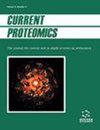Unraveling Potential Candidate Targets Associated with Expression of p16INK4a or p16 Truncated Fragment by Comparative Proteomics Analysis
IF 0.5
4区 生物学
Q4 BIOCHEMICAL RESEARCH METHODS
引用次数: 0
Abstract
P16 is a tumor suppressor protein that is significantly involved in cycle regulation through the reduction of cell progression from G1 phase to S phase via CDK-cyclin D/p16INK4a/pRb/E2F cascade. The minimum functional domain of p16 has been uncovered that may function comparable to wild type p16. To expand the knowledge on molecules and mechanisms by which p16 or p1666-156 fragment suppresses human fibrosarcoma cell line growth, differential proteome profiles of fibrosarcoma cells following p16 full length or the functional domain overexpression were analyzed. Following transfecting HT-1080 fibrosarcoma cells with p16 full length, p1666-156 truncated form, and pcDNA3.1 empty vector, protein extract of each sample was harvested and clarified by centrifugation, and then the protein content was determined via Bradford assay. All protein extract of each sample was analyzed by two-dimensional gel electrophoresis. Immunoblot analysis was performed as further validation of the expression status of identified proteins. Expression of p16 or p1666-156 fragment could induce mostly common alterations (up/down-regulation) of proteome profile of HT-1080 cells. Mass spectrometry identification of the differentially expressed protein spots revealed several proteins that were grouped in functional clusters, including cell cycle regulation and proliferation, cell migration and structure, oxidative stress, protein metabolism, epigenetic regulation, and signal transduction. The minimum functional domain of p16 could act in the same way as p16 full length. Also, these new findings can significantly enrich the understanding of p16 growth-suppressive function at the molecular level by the introduction of potential candidate targets for new treatment strategies. Furthermore, the present study provides strong evidence on the functional efficacy of the identified fragment of p16 for further attempts toward peptidomimetic drug design or gene transfer to block cancer cell proliferation.通过比较蛋白质组学分析揭示与p16INK4a或p16截断片段表达相关的潜在候选靶点
P16是一种肿瘤抑制蛋白,通过CDK-cyclin D/p16INK4a/pRb/E2F级联减少细胞从G1期向S期的进展,显著参与周期调节。p16的最小功能域已经被发现,其功能可能与野生型p16相当。为了进一步了解p16或p1666-156片段抑制人纤维肉瘤细胞系生长的分子和机制,我们分析了p16全长或功能域过表达后纤维肉瘤细胞的差异蛋白质组谱。以p16全长、p1666-156截断、pcDNA3.1空载体转染HT-1080纤维肉瘤细胞后,收获各样品蛋白提取物,离心澄清,Bradford法测定蛋白含量。每个样品的所有蛋白提取物均采用双向凝胶电泳分析。进行免疫印迹分析以进一步验证鉴定蛋白的表达状态。p16或p1666-156片段的表达可引起HT-1080细胞中最常见的蛋白质组谱改变(上调/下调)。质谱分析显示,这些差异表达的蛋白点被归类为功能簇,包括细胞周期调控和增殖、细胞迁移和结构、氧化应激、蛋白质代谢、表观遗传调控和信号转导。p16的最小功能域与p16全长的作用方式相同。此外,这些新发现可以通过引入新的治疗策略的潜在候选靶点,在分子水平上显著丰富对p16生长抑制功能的理解。此外,本研究为p16片段的功能功效提供了强有力的证据,为进一步尝试拟肽药物设计或基因转移来阻止癌细胞增殖提供了证据。
本文章由计算机程序翻译,如有差异,请以英文原文为准。
求助全文
约1分钟内获得全文
求助全文
来源期刊

Current Proteomics
BIOCHEMICAL RESEARCH METHODS-BIOCHEMISTRY & MOLECULAR BIOLOGY
CiteScore
1.60
自引率
0.00%
发文量
25
审稿时长
>0 weeks
期刊介绍:
Research in the emerging field of proteomics is growing at an extremely rapid rate. The principal aim of Current Proteomics is to publish well-timed in-depth/mini review articles in this fast-expanding area on topics relevant and significant to the development of proteomics. Current Proteomics is an essential journal for everyone involved in proteomics and related fields in both academia and industry.
Current Proteomics publishes in-depth/mini review articles in all aspects of the fast-expanding field of proteomics. All areas of proteomics are covered together with the methodology, software, databases, technological advances and applications of proteomics, including functional proteomics. Diverse technologies covered include but are not limited to:
Protein separation and characterization techniques
2-D gel electrophoresis and image analysis
Techniques for protein expression profiling including mass spectrometry-based methods and algorithms for correlative database searching
Determination of co-translational and post- translational modification of proteins
Protein/peptide microarrays
Biomolecular interaction analysis
Analysis of protein complexes
Yeast two-hybrid projects
Protein-protein interaction (protein interactome) pathways and cell signaling networks
Systems biology
Proteome informatics (bioinformatics)
Knowledge integration and management tools
High-throughput protein structural studies (using mass spectrometry, nuclear magnetic resonance and X-ray crystallography)
High-throughput computational methods for protein 3-D structure as well as function determination
Robotics, nanotechnology, and microfluidics.
 求助内容:
求助内容: 应助结果提醒方式:
应助结果提醒方式:


